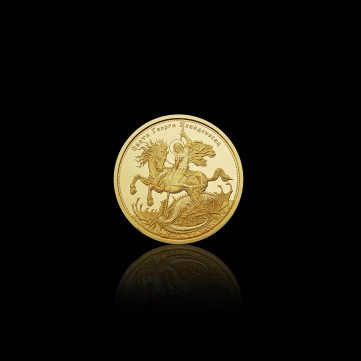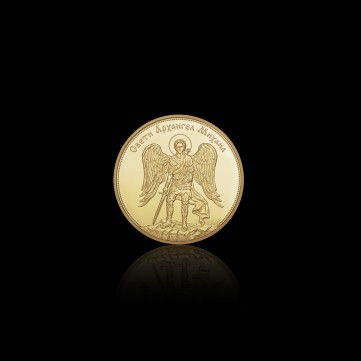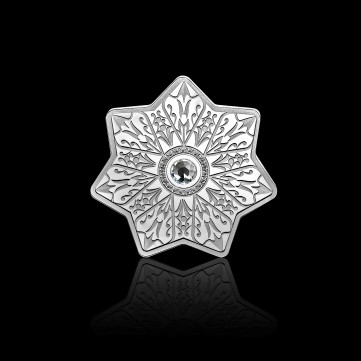Nestinari Silver Medal, 31.1g
159.00 BGNA priceless example of Bulgaria’s intangible cultural heritage, the nestinarstvo tradition has been capturing the imagination from times immemorial to this day. It now sparks to life in vibrant colour on the obverse of a medal made of 31.1 g of 999.9 fine silver, enhanced with digital colourisation.
In the village of Bulgari in the Strandzha mountain lives an ancient and mysterious tradition, enmeshed with newer Christian beliefs – a ritual dance performed on burning embers in honour of the Saints Constantine and Helena, the culmination of the nestinarstvo folk cycle. We pay tribute to this one-of-a-kind custom – part of UNESCO’s Representative List of the Intangible Cultural Heritage of Humanity – by creating a medal made of pure silver and digitally colourised for greater depth.
Every year on June 3rd – the feast of Saints Helena and Constantine as observed according to the Julian calendar – led by the sound of a special drum, the keepers of the nestinarstvo tradition dance barefoot on live embers. Thousands flock to Bulgari to see the spectacle with their own eyes, but behind this fascinating rite lies an intricate belief system – according to the locals, this ritual earns the benevolence of Saint Constantine and his companion Saint Helena and brings good health and prosperity upon the community. In the past there were more than 20 settlements on the territory of Bulgaria and modern Turkey, but today it remains in its authentic form in a single village.
The obverse of the Nestinari silver medal depicts the iconic culmination of the Panagyr of the two saints – three nestinari that dance boldly on the embers, barefoot, but unharmed. The central figure is holding an icon of Saints Constantine and Helena. The bright digital print breathes life into the scene, transporting us to the very depths of the Strandzha mountain.The reverse is decorated with a relief illustration of a shevitsa, traditional hand-embroidery from the Samokov area – the unifying element for the Bulgarian Customs and Traditions program.
The Nestinari medal is minted in proof matt-gloss quality out of 31.1 g of 999.9 fine silver in a diameter of 45 mm. On the obverse, the circumscription “Nestinari” and the elements of the design protrude with a glossy finish on a matt field – quality, known as reverse proof.
The medal is suitable both as an addition to a personal collection and as an original gift for one’s nameday or another occasion. It comes in an elegant leather box with a themed packaging that also serves as the product’s quality certificate.
Metal
Silver
Weight
31.1
g
Dimensions
45
mm
Purity
999.9/1000
Edging
Smooth
Quality
Proof
Circulation
1000
pcs.
Bulgarian Customs and Traditions
The Bulgarian Customs and Traditions program is inspired by the centuries-old customs that have preserved the spirit of the Bulgarian people throughout the centuries - a fascinating mix of Christian beliefs and pagan rituals. The lives of many generations of Bulgarians have historically revolved around the cycles of nature and agriculture.
The Bulgarian Customs and Traditions program comprises several collections dedicated to a variety of emblematic aspects of Bulgarian culture. The obverse design of every medal in this program is enhanced through digital colourisation, which highlights the details of the relief and breathes life into the composition. The colours are natural and vibrant, emphasising the respect for and closeness to nature that is inherent to our traditions. The floral motifs on the reverse sides are a recreation of the traditional hand embroidery of the Samokov area of Bulgaria.
Nestinarstvo
Nestinarstvo is one of the most enigmatic traditions found in our lands. As of 2009, it is on UNESCO’s Representative List of the Intangible Cultural Heritage of Humanity. Its origin and meaning remains a mystery to historians to this very day – various theories associate it with the Thracian cult of Dionysus-Sabazios, but alternate versions exist, and the truth itself is subject to historical debate.
Legends remain of a village called Tripori – the birthplace of the nestinarstvo tradition. Its population was of mixed Bulgarian-Greek heritage. Its residents migrated to some 20-30 villages in the region between the mountain of Strandzha and the Black Sea, on a territory that today falls within the borders of Bulgaria and Turkey, where they continued to practice and develop the custom. Today it exists in its authentic form only in the village of Bulgari, but fire dancing as a tourist attraction can be found all over Bulgaria.
The rich ritualism of the nestinarstvo tradition takes place all year round and involves the feast days of multiple Christian saints as seen through the eyes of the local culture. Saint Constantine is the principal saint of the nestinari, and Saint Helena is his companion, though Bulgarian folklore depicts them as siblings or even spouses, rather than mother and son as they were in life. It is on their feast day, according to the outdated Julian calendar, that the famous barefoot fire dancing rite takes place.
The centerpiece of this tradition are special Orthodox icons, most often depicting the saints Helena and Constantine. The preparations for the grand celebration begin with the transportation of the icons to a hut dedicated to this purpose, where they are smoke cleansed, “clothed” in red sheathes or “shirts”, and taken via procession to the sacred spring of Saint Constantine for sanctification. There they are ritualistically washed and returned to the hut where an offering is made to the saints the icons honour.
In the evening, the nestinari visit the icons at the hut, breathe in frankincense smoke, and pray – and the celebratory procession begins. Accompanied by the sound of a special drum, they carry the icons to the village square where the hot coals are prepped and waiting. In a state of trance, the nestinari let out a series of gasps and calls and with an unusual flat step begin to tread through the embers without sustaining any burns.
Nestinarstvo, locally known as the “nestinarstvo sickness”, gets passed down through specific families. Both men and women can be nestinari, but the women outnumber the men. They speak of visions received during the dance or of an unexplained feeling of cold that can only be driven away by the warmth of the coals. In the past, some of them would speak prophecies, and this would even extend to members of the audience. Nestinarstvo is also thought to have healing properties – the practitioners sometimes carry children, elderly, and sick people for good health and longevity.
We ship our orders with Econt Express. The cost of delivery is at the customer's expense and includes insurance, cash on the delivery fee, if applicable, and courier service. The total delivery cost is formed based on the chosen method of payment and the method of delivery.
Orders received by 3 p.m. on working days and chosen payment method cash on delivery or credit card are processed and shipped on the same day. Orders received after 3 p.m. or during the weekend, are processed and despatched on the next working day.
Each shipment has the "Check" option. In case the customer decides to return the order, the delivery and return costs are at the expense of the customer.
Storage of investment products and medals with numismatic value
Owners of gold and silver products with the Bulmint brand should take into account some specific storage conditions. Gold and silver are precious metals, which are very soft and easy to bend/deform. The products must be kept in a place of low humidity where the temperature does not exceed 50 degrees Celsius, in order not to impair the integrity of the package. Please do not use a sharp object on the package or the product itself – you risk damaging it.










